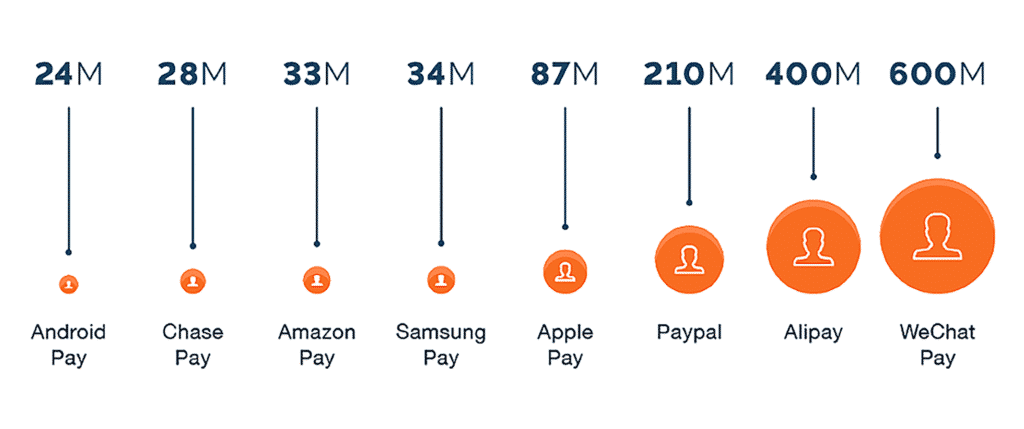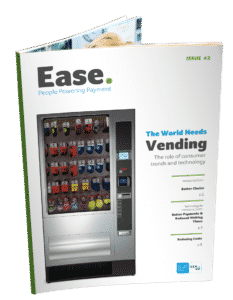The vending industry is vibrant and thriving. An influx of smaller companies into the European and American market has pushed innovation and tested the boundaries.
A vending machine used to conjure up the idea of a big rusty box, rattling with coins. Well, how things have changed! From smart technology to healthier choices, the vending industry is offering a modern solution to refreshment on-the-go. And much more besides.
In this article, we will look at seven of the most exciting trends in vending.
#1 Cashless payments
Technology has revolutionised payments in general, which is a topic very close to our hearts at CCV. According to the European Central Bank, the total number of non-cash payments in the EU increased by 7.9% to 134 billion in 2017 compared with the previous year.
The vending industry is helping to drive this shift in consumer behaviour. No longer are people bound by loose coins bouncing around in their pockets. Instead, card payment systems have become prevalent – and even legacy machines are being updated with this technology.
Less cash means increased convenience for the vendor and the customer alike. Most people use a contactless debit or credit card, but there are lots of new payment options. Vending machines can now take mobile payments, or link-up to online customer accounts via an app.
#2 Healthier choices
Vending machines have become synonymous with sweet or salty snacks. There’s a time and a place for these, certainly. But according to research, the healthy snacks market is now worth over $23 billion globally. As the demand for nutritious nibbles grows, it’s only natural that the vending industry gets wholeheartedly involved.
Just because we want food fast, doesn’t mean we want fast food. Healthy vending machines are popping up all over Europe and the US. This initiative is driven on a local and national basis, as authorities, councils, and governments all tackle obesity.
We spoke with one brand at the forefront of healthy vending, Fresh Bowl. They’re making waves in New York, with the added bonus of plastic-free reusable packaging.
Co-founder Chloe Vichot said:
“The main driver is that people want to eat well, but don’t always have the time to enjoy a real meal. Our goal is to bring people restaurant-quality meals in a vending machine, and transform the rushed lunch break into a fulfilling experience. I think that in five or ten years, we will see vending machines or automats everywhere: for our morning latte, for breakfast, to buy a charger, an ice cream, and more. Rents and building costs are making it difficult for storefronts to survive. Wages are going up. Above all, people are on-the-go more, and always look out for convenient options…”
“The challenge is to educate our customers on how fresh our food is, where it was made, and by whom. With vending, you tend to lack the charm and conviviality of owning a café. But there are huge opportunities. People are asking for this. Every time they see one of our machines, they’re excited and ask if we can bring it to more locations.”
#3 New locations
We’re used to seeing vending machines in offices, schools, hospitals, and at railways stations. But there are many more ideal spots. As vending machine design improves, it’s feasible to sell products in a variety of new locations, thus expanding the industry as a whole.
The rise of healthy, high-quality, and specialist vending machines creates an opportunity. What was seen as a “cheap-and-cheerful” refreshment solution is now elevated to something better. Upmarket hotels, airports, and university campuses are now attractive locations.
#4 More varied products
Beverage vending is currently the biggest part of the industry, and food snacks is second. But this isn’t the limit to what vending machines can offer.
Japan has the highest density of vending machines in the world. Reasons include low vandalism rates, an openness to automation, expensive real estate, and a strong demand for convenience. Machines usually offer cold drinks, but stranger items are available; including unmentionables!
In Japanese vending machines, you might find umbrellas, hamburgers, socks, surgical masks, earplugs, and everything in between. It would need quite a shift in Europe and the USA for this to become the norm, but inspiration has been taken from this vast range of products.
#5 Vegan and gluten-free products
Veganism is no fad. It has experienced unstoppable growth over the past ten years in Europe and the US, according to a wealth of research. Of course, this walks hand-in-hand with having healthier choices in our vending machines, but catering for plant-based diets is now essential.
Vegan vending machines have started to appear, but it’s also become the norm for vegan snacks to be advertised and stocked alongside everything else. As the appetite for veganism grows over the next ten years, we should expect this trend to continue.
The “free-from” food industry is skyrocketing, and gluten-free foods are key. Coeliac disease affects around 1% of the population, but mild-to-moderate gluten sensitivity is more prevalent. People are also choosing to cut-down on gluten for weight-loss and general health reasons.
According to research, the global gluten-free market grew from $1.7 billion in 2011 to $3.5 billion in 2016. It’s forecasted to reach $4.6 billion in 2020. The vending industry is playing its part by stocking more gluten-free options, and this will soon become standard practice.
Photo credit: Payment Machine
#6 Mobile payments
This is obviously a type of cashless payment, which we covered in the first section. But the rise of mobile wallets is something worth exploring by itself.
There are some recognised barriers to the growth of mobile payments, as outlined by Business Insider. One main obstacle is people’s reluctance to change their habits. The idea of a mobile wallet is fantastically convenient, but routines are difficult to nudge in a new direction.
That said, mobile payments are growing. Research suggests that over 87 million people are using Apple Pay worldwide, and 34 million people use Samsung Pay. China leads the way for mobile payments, with an estimated 47% of smartphone owners actively using mobile wallets. This is dominated by WeChat Pay with 600 million users and Alipay with 400 million users.
As mobile payments become more common, the vending industry is right to integrate this option into machines. Some have reported a slow start, but the trend is impossible to ignore.
#7 Personalisation
“The usual today?” is a phrase you’d expect to hear from a local shopkeeper, but not from a vending machine. This may change, as smart machines could use smartphone indicators to identify the customer. What if it knew your preferred language, and your first-choice drink?
Perhaps more unnerving is the idea that vending machines can profile the customer using cameras and databases – in order to offer the most relevant products to certain demographics.
In fact, this happened in Japan back in 2010. Whilst it hasn’t caught the industry by storm yet, the technology has improved drastically and could be integrated in the future.
Conclusion
At the heart of our seven vending industry trends are two strong pillars: technology and health. People will always need refreshment on-the-go, and it’s the role of venders to offer ultimate convenience and choice. As a result, everyone benefits.
We’re yet to see whether blockchain payments become mainstream in the vending industry, but this is another technological trend to monitor. An age-verifying blockchain machine has been created in the US with a view to dispensing beer, and this could be developed in exciting ways.
Smart technology and connectivity will also allow owners to track sales and revenue patterns in more detail. As the data gets deeper and analysis becomes easier, vendors can stock the right products, on the right days, in the right places.
Smart vending machines are already widespread, and this creates opportunities for vendors to connect with customers in new and exciting ways. From convenient payment to a personalised service, the future of vending looks fresh.
Interested to learn more about the vending business?
Get your free Vending Magazine and discover how to maximise profit with vending machines.
DOWNLOAD HERE
Share this article on social media:


